Garden/Backyard Farming: Tips for Growing Your Own Food
7 May 2023 2023-07-07 17:10Garden/Backyard Farming: Tips for Growing Your Own Food

Garden/Backyard Farming: Tips for Growing Your Own Food
Increasingly today, people are turning to garden or backyard agriculture to grow their own food. Horticulture is a great option for both obtaining healthy and fresh products and using natural resources in a more sustainable way. In this blog post, we will share important tips you should consider when farming in your garden or backyard.
- Do Research: Before you start gardening, it is important to do basic research on the products you will make and the plants you want to grow. Determine which plants will grow best by considering your climate and soil conditions. Learn which plants should be planted in which seasons and which plants are compatible with each other. Also, learn by researching topics such as gardening techniques, fertilization methods and pest control.
- Soil Preparation: When gardening, it is necessary to pay attention to fertile soil preparation. The soil must provide the nutrients necessary for plants to grow healthy and strong. Here are some steps in soil preparation:
- Soil Analysis: You can determine the nutrient deficiencies of the soil by having a soil analysis of your garden. This analysis measures the soil's pH level, organic matter content and level of nutrients. Based on the results obtained, you can add the necessary fertilizers or organic materials to amend the soil.
- Soil Fertilization: In horticulture, adding natural fertilizers to the soil helps nourish the plants. You can use materials such as organic fertilizers, compost or animal manure. You can meet the nutritional needs of plants by mixing these fertilizers into the soil. Additionally, it is important to fertilize regularly according to the growth stages of the plants.
- Soil Improvement: It is important to add organic matter to improve the soil. Compost is an ideal option for enriching the garden with organic matter. Compost is obtained by the natural decomposition of organic materials such as plant waste, kitchen waste and leaves. By mixing this material into the soil, you can improve the structure of the soil and increase its water retention capacity.
- Soil Drainage: Good soil drainage is important for plants to grow healthy. The soil should not have problems such as excessive water accumulation or rapid drainage of water. You can add sand or organic matter to improve soil drainage. This will ensure that the soil is aerated and the roots grow healthy.
- Plant Selection: When choosing the plants you will grow in your garden, choose those that are compatible with your climate and region. You can provide natural diversity by using local seeds or seedlings. You can also choose vegetables, fruits, or herbs based on your family's needs and preferences. To grow plants with different growth periods together, plan your planting schedule and space plants appropriately.
- Watering and Maintenance: Regular watering is important for the growth and development of plants. Determine the appropriate watering schedule for your plants and water the plants as needed. Generally, watering in the morning or evening hours ensures better absorption of water into the plants. Avoid overwatering your plants as this can cause root rot. Also, do regular maintenance to keep your plants weeded and protected from pests. If necessary, you can fight pests using organic pesticides or natural methods.
- Fertilization: It is important to fertilize regularly to meet the nutritional needs of your plants. You can feed your plants using organic fertilizers or compost. Adjust your fertilization schedule according to the growth stages of the plants. Younger plants generally need more frequent fertilization, but be careful and avoid over-fertilizing as this can cause plants to burn or overgrow.
- Pest Control: When gardening, it is important to prevent pests from damaging your plants. Opt for natural pest control methods to avoid the use of chemical pesticides. For example, some plants can keep pests away, so you can plant them around your garden to create a natural barrier. Also, check plants regularly and take early measures to combat pests.
- Harvest and Storage: When it comes time to harvest your plants, harvest them at the right time. The harvesting method and time for each plant may be different, so learn the harvesting techniques appropriate for your plants. Clean, wash and store your harvested produce correctly. While some products should be consumed fresh, some can be stored for a long time. You can extend the usage time of your excess products by methods such as drying, freezing or canning.




